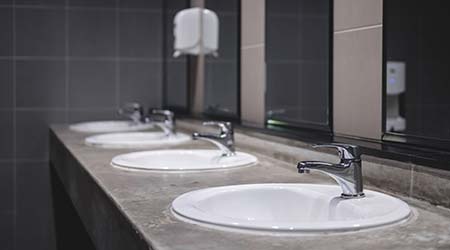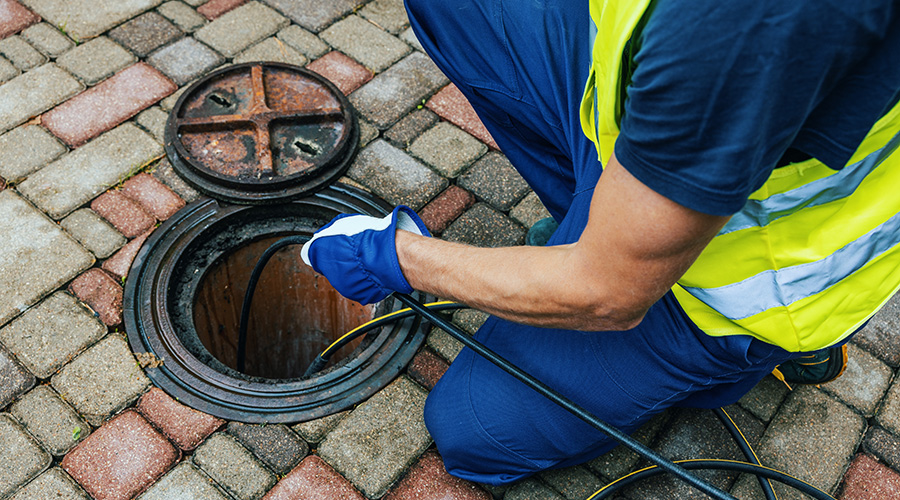How Good Design Prevents Complaints about Restrooms
Take a close look at component-selection criteria, restroom use, and maintainability.
Surveys of facility managers have shown that the frequency of complaints about restrooms ranks second only to those concerning building temperatures. Common complaints range from cleanliness to lack of supplies. There is no question that budget constraints have resulted in smaller maintenance and cleaning crews, higher rates of personnel turnover, and constraints on what types of cleaning equipment and supplies can be purchased. As a result, many have had to cut back on the frequency of cleaning activities, which can add to the number of complaints.
The problem for facility managers is that poorly maintained restrooms leave a lasting impression on both visitors and building occupants that is difficult to overcome. And while there is little doubt that maintaining restrooms at the expected level poses a challenge to operations, there are steps that facility managers can take to minimize or totally eliminate the causes of these complaints.
Many of the most common complaints concerning the conditions found in restrooms can be traced back to the design of the restroom. Poor decisions made during the planning process — often made to reduce construction costs — can lead to long-term operational issues. Lower cost finishes and components often are more difficult to clean or are more prone to failure than higher cost ones.
Even when there is nothing wrong with the components specified, selection of the wrong type of components can lead to complaints. For example, fixtures that readily show dulled finishes and soap film create the impression that the restroom is unclean when in fact it may be sanitary.
To be effective, a design must consider all elements of the restroom from the ceiling to the floor, including all finishes and surfaces. Even the lighting system must be carefully considered, as poorly lit areas or improperly placed fixtures can create the appearance of a dingy restroom.
Restroom designs should also be tailored to the needs of the facility. A restroom in a high school will have far different requirements than one in an office. A heavily trafficked restroom poses different challenges than one serving an executive office suite and must be set up differently both to ease the flow of traffic and to ensure that the materials selected for use will be able to withstand that level of use.
If the restroom is in an area where vandalism is a concern, then materials, fixtures, and finishes must be selected based on their ability to resist vandals. For example, paper towels provide material that could be used to clog toilets; installing hand dryers can help prevent that problem. Facility managers should also consider the use of graffiti-resistant partitions. In these facilities, performance should take precedence over appearance.
Smart design goes beyond the restroom itself. Smart design includes providing sufficient storage space close to the restroom for tools and supplies. If it is too difficult to get cleaning supplies and equipment to the restroom, cleaning will suffer, and with it the cleanliness of the restroom — a common reason for complaints.
Too many facilities are designed with a focus on appearance, ignoring maintenance. If you want a restroom that is easy to maintain, approach its design by looking through the eyes of those who must maintain it. What do they need to accomplish the task? Which materials are easier to clean? Which fixtures are easier to repair? What stands up to the anticipated level of use?
Making Sure That Fixtures Work
For a good example of how design and maintenance work together, consider the problem of fixtures not working — a nuisance to everyone and an invitation to complaints. In smaller restrooms, users may have to find their way to the next closest restroom. In heavily traveled restrooms, failed fixtures can result in lines and frustration.
Fixtures fail for a wide range of reasons. The quality of the fixture may be inferior, making it prone to clogging or other failure. With hands-free fixtures becoming more widely used, batteries have to be replaced on a regular basis. Vandalism can damage fixtures and make them inoperative. Even normal wear and tear takes its toll on fixtures.
Reducing fixture failures starts with the design process. As noted earlier, the best fixture for a particular application seldom is the lowest cost. Purchase decisions must be made on quality and life-cycle costs, not just first costs.
It is equally important for design to consider maintenance. Isolation valves should be installed on every fixture to allow maintenance personnel to work on a failed fixture without having to take the entire restroom out of service.
Related Topics:













